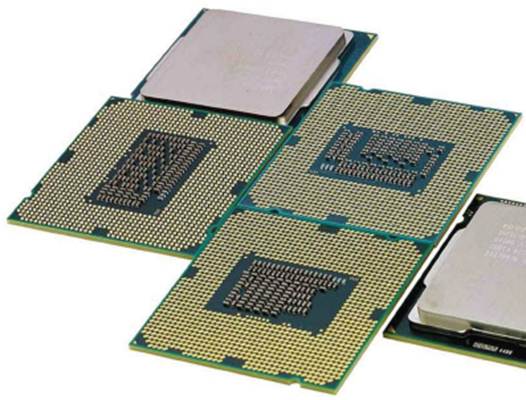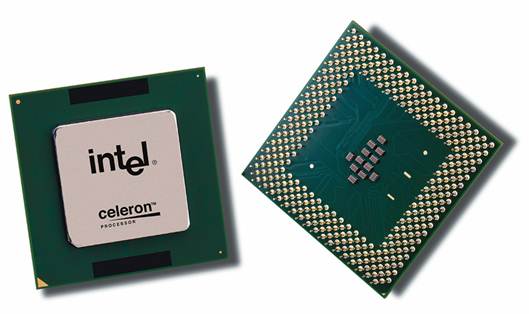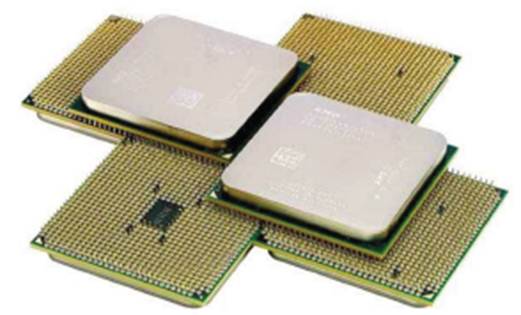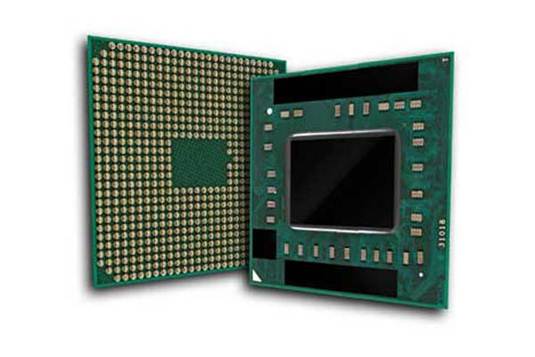Intel Celeron and Pentium
These are Sandy Bridge chips masked
in old brands, with mixed results
The venerable Celeron and Pentium brands
are still with us, but these days they’re just rebranded low-end Sandy Bridge
processors.
Five Celerons are widely available, with
clock speeds ranging from 1.6GHz to 2.5GHz across single- and dual-core chips -
figures that are much lower than many of Intel’s Core-branded parts. Only one,
the low-power G460, offers Hyper-Threading, there’s no Turbo Boost, and old,
tweaked HD Graphics 2000 cores are used throughout.

Intel
Celeron and Pentium
The eight Pentiums are all dual core and
run between 2.2GHz and 3.1GHz, but there’s still no sign of Hyper-Threading or
Turbo Boost. They have 3MB of L3 cache, and their HD Graphics 2000 cores are
clocked 100MHz higher than the Celerons - not that the slight speed bump will
make the weak graphics chip produce smooth results in games.
Performance
The two single-core Celerons aren’t much
faster than Atom- based netbooks, with the 1.8GHz G460 scoring a paltry 0.29 in
our benchmarks. Their saving grace is their price: they cost only $41 and $44,
which makes them this month’s cheapest processors by a considerable margin.
The rest of the Celerons are more capable.
The 2.4GHz G530 and 2.5GHz G540 both scored 0.55, outpacing the two low-voltage
Pentium G620T and G630T parts. These Celerons are cheaper, too - $47 and $53
compared to the $65 and $81 Pentiums.
The remaining six Pentiums range from the
2.6GHz G620 to the 3.1GHz G870, and return benchmark scores between 0.57 and
0.65. That isn’t far behind low-end Core i3 chips, and the Pentium parts are
much cheaper - the G620 costs only $66 and the more powerful G860 scored 0.64
for only $92. The cheapest Core i3, meanwhile, weighs in at $132.
The verdict
The cheapest chip we’d choose from this
particular group is the Celeron G530. Its benchmark score of 0.55 means that it
isn’t far behind Pentium performance, but its $47 price is $18 less than any
Pentium. Buy any of the even cheaper Celerons and the few quid you save will
quickly be forgotten in your annoyance at your PC’s sluggish performance; the
lowest-end chips offer barely half the application performance.
Value for money varies when it comes to the
eight Pentiums on test. The G840 scored a mediocre 0.59 but costs $81, for
example, which looks poor next to the similarly quick and cheaper G630. The
top-of-the-range G870 costs $111for a score of 0.65, but the G860 costs $92 and
scored 0.64. That’s barely slower at all, and it makes the decision a
no-brainer.
What's in a name?
Pentiums weren't always low-end. Following
its release in 1993, the Pentium 60 was Intel's top CPU and its success led to
the Pentium II, III and 4 - and the Pentium D range, which contained Intel's
first dual-core processors.

Pentium lost its top spot in 2006 to Core
2, but in 2007, Pentium returned as a low-cost brand favoured by overclockers
and budget builders. Releases since then have encompassed the Penryn, Westmere
and Sandy Bridge architectures.
Celerons have always been budget chips, but
in 1999 they were designed to compete with Cyrix and IDT's WinChips as well as
AMD - with great success.
Since then, the Celeron brand has
consistently been used for the lowest-speed chips, even appearing in netbooks.
Today's models may be based on the Sandy Bridge architecture, with single- and
dual-core models available, but they aren't good for much more than basic
everyday applications.
|
Model
|
Speed
|
Responsiveness
|
Media
|
Multitasking
|
Overall
|
Price (inc VAT)
|
Rating
|
|
Celeron G440
|
1.6GHz
|
0.53
|
0.27
|
0.03
|
0.27
|
$33 ($41)
|
2/6
|
|
Celeron G460
|
1.8GHz
|
0.54
|
0.3
|
0.03
|
0.29
|
$36 ($44)
|
2/6
|
|
Celeron G530T
|
2GHz
|
0.73
|
0.43
|
0.27
|
0.47
|
$45 ($56)
|
3/6
|
|
Celeron G530
|
2.4GHz
|
0.76
|
0.51
|
0.34
|
0.55
|
$38 ($47)
|
4/6
|
|
Celeron G540
|
2.5GHz
|
0.8
|
0.52
|
0.35
|
0.55
|
$44 ($53)
|
3/6
|
|
Pentium G620T
|
2.2GHz
|
0.76
|
0.46
|
0.31
|
0.51
|
$53 ($65)
|
3/6
|
|
Pentium G630T
|
2.3GHz
|
0.76
|
0.47
|
0.34
|
0.52
|
$65 ($81)
|
2/6
|
|
Pentium G620
|
2.6GHz
|
0.79
|
0.55
|
0.39
|
0.57
|
$54 ($66)
|
4/6
|
|
Pentium G630
|
2.7GHz
|
0.79
|
0.57
|
0.38
|
0.58
|
$56 ($68)
|
4/6
|
|
Pentium G840
|
2.8GHz
|
0.79
|
0.61
|
0.39
|
0.59
|
$68 ($81)
|
3/6
|
|
Pentium G850
|
2.9GHz
|
0.82
|
0.64
|
0.42
|
0.63
|
$80 ($96)
|
4/6
|
|
Pentium G860
|
3GHz
|
0.86
|
0.63
|
0.42
|
0.64
|
$75 ($92)
|
4/6
|
|
Pentium G870
|
3.1GHz
|
0.86
|
0.65
|
0.44
|
0.65
|
$92 ($111)
|
3/6
|
AMD FX series
Reasonable prices, but for
performance, AMD remains some way behind the Intel juggernaut
AMD has virtually handed the high-end CPU
market to Intel. Although the Bulldozer architecture in the FX chips was
designed from scratch, performance is on a par with the Core i5 - AMD lacks any
chips that can match Core i7 speeds.

AMD
FX series
FX chips are similar to Intel’s Sandy and
Ivy Bridge parts, with each Bulldozer module showing as two logical cores in a
similar fashion to Hyper-Threading. Turbo Core is like Turbo Boost,
overclocking two cores at a time.
A top-end FX-8150 will set you back $212,
less than a Core i5-2500K. Parts such as the $110 FX-4100 compete well with the
Core i3 chips, most of which cost around $150.
Performance
The $110 FX-4100 and the $150 FX-4170
scored 0.71 and 0.78 respectively in our benchmarks. That’s reasonable power
for little cost - the same performance from a Core i3 costs at least $132.
However, AMD’s own A-Series is almost as
quick, often costs less and has Radeon graphics.
The $137 FX-6100 scored 0.75, so it doesn’t
stand out from a host of other FX and Core i3 parts. The FX-6200 was better -
with 0.82 - but at $179, it’s more expensive than every Core i3, without
Intel’s power efficiency or graphics.
The best FX chips were left behind by both
Sandy Bridge and Ivy Bridge Core i5s. The $173 FX-8120 scored 0.86, and the
$212 FX-8150 scored 0.89.
All but the low-voltage Core i5 chips
trounced FX in benchmarks and at the checkout: every full-power Core i5 scored
between 0.92 and 1.04.
The verdict
AMD hasn’t placed much emphasis on FX, and
we can see why. Top-end chips are nowhere near Intel’s flagships, and low-end
chips are less attractive than Core i3s and AMD’s own APUs. If you have an AMD
motherboard there may be some appeal, but we wouldn’t recommend these chips.
|
Model
|
Speed
|
Responsiveness
|
Media
|
Multitasking
|
Overall
|
Price (inc VAT)
|
Rating
|
|
FX-4100
|
3.6GHz
|
0.86
|
0.69
|
0.57
|
0.71
|
$90 ($110)
|
3/6
|
|
FX-4170
|
4.2GHz
|
0.92
|
0.76
|
0.65
|
0.78
|
$125 ($150)
|
3/6
|
|
FX-6100
|
3.3GHz
|
0.83
|
0.75
|
0.68
|
0.75
|
$113 ($137)
|
3/6
|
|
FX-6200
|
3.8GHz
|
0.89
|
0.82
|
0.75
|
0.82
|
$149 ($179)
|
3/6
|
|
FX-8120
|
3.1GHz
|
0.87
|
0.88
|
0.84
|
0.86
|
$143 ($173)
|
4/6
|
|
FX-8150
|
3.6GHz
|
0.9
|
0.91
|
0.87
|
0.89
|
$176 ($212)
|
3/6
|
AMD A-Series
AMD's APUs mix decent application
performance with powerful graphics, but can they compete with Intel?
With its A-Series chips, AMD switched its
focus. They’re known as APUs, or accelerated processing units, since they
include both a processor core and a relatively powerful Radeon graphics core in
the same package.
All of the 32nm Radeons inside A-Series
APUs share architecture with last year’s Radeon HD 6000 Series. Three appear
across the range: the HD 6410D in the A4 APUs; the HD 6530D in A6-branded
parts; and the high-end HD 6550D in A8 chips.

AMD unveils A Series APUs Enable Best in Class PC Mobility
The bottom-end HD 6410D boasts the same
600MHz clock speed as that of the top-end HD 6550D, but has only 160 stream
processors compared to the latter’s 400.
The mid-range HD 6530D is clocked at a
lower 443MHz, but has 320 stream processors. All three use a 128-bit memory
bus, and although they lack the power to run current games across multiple
monitors, they support three-screen Eyefinity.
Elsewhere, the A-Series architecture isn’t
far removed from AMD’s other desktop chips. Some of the APUs feature Turbo
Core, which dynamically boosts clock speeds by up to 300MHz, and there are
varying levels of cache. A4-Series chips have a total of 1MB, A6 chips 3MB or
4MB, and A8 cores have 4MB.
The A6 and A8-Series have improved memory
support, too, and are capable of handling 1,866MHz DDR3 RAM; the A4 chips work
with only 1,600MHz memory.
Finally, we’re also including a quartet of
Athlon II X4 processors in this roundup. The name may be an old one, but these
are new chips based on the same architecture as the A-Series, albeit without
the integrated graphics core. They’re quad-core chips with frequencies ranging
from 2.6GHz to 3GHz - higher than several A-Series processors, but without the
Turbo Core feature.
Performance
The A-Series will win few awards for
application performance. The A4-3300 and A4-3400 scored 0.49 and 0.51 in our
benchmarks, behind the slowest of Intel’s Core i3 chips and more in line with
the cheaper Pentiums. They’re priced similarly, but the AMD chips caused our
test rig to draw more than twice the power of the Intel chips at peak
performance levels.
AMD’s mid-range APUs put on a better show.
The A6-3500 scored 0.64, and both the A6-3650 and A6-3670K scored 0.67. Only
the two most expensive Pentiums can compete with that speed - and here, the
combination of speed and graphical power makes the AMD chips the more tempting
option.
The pinnacle of the A-Series is a trio of
A8-branded parts, but there’s no significant performance increase over the
mid-range A6-branded chips.
In fact, unless you regularly use
multithreaded software to take advantage of the extra cores, they’re barely any
faster at all, with scores of 0.66, 0.69 and 0.7 in our benchmarks.
The verdict
The AMD A-Series is a mixed bag. At the
bottom of the pile, application performance is nothing special and the weaker
graphics cores are no quicker than those of Intel. They’re inefficient, too,
when it comes to power draw.
The mid-range is better. The A6-3650 is the
standout chip, with identical performance in applications for less cash than
the overclockable A6-3670K, and better performance than the equivalent
Pentiums. The addition of a good graphics chip makes it ideal for a low-end
entertainment system, which is something Intel can’t boast at this price point.
At the top end, the A8-3850 and A8-3870K
outpace the best Pentiums, and come close to the low-end Core i3s; they also
have much better graphics. As you move up the scale, the question of graphics
rears its head, though: if you intend to use a separate graphics card, the
major strength of these APUs is diminished.
The Athlon IIX4 chips are reasonable for
those on a tight budget. There’s no Radeon core, but performance sits between
the Pentium and Core i3 ranges, and prices are a little lower than you’ll pay
for the best Pentiums. They aren’t particularly frugal, but we’d choose the
Athlon IIX4 65IK, as it’s unlocked for overclocking.
|
Model
|
Speed
|
Responsiveness
|
Media
|
Multitasking
|
Overall
|
Price (inc VAT)
|
Rating
|
|
Athlon IIX4 631
|
2.6GHz
|
0.82
|
0.62
|
0.56
|
0.67
|
$62 ($75)
|
4/6
|
|
Athlon IIX4 641
|
2.8GHz
|
0.84
|
0.65
|
0.59
|
0.69
|
$74 ($89)
|
3/6
|
|
Athlon IIX4 651
|
3GHz
|
0.87
|
0.68
|
0.63
|
0.73
|
$81 ($98)
|
4/6
|
|
Athlon IIX4 651K
|
3GHz
|
0.87
|
0.68
|
0.63
|
0.73
|
$83 ($101)
|
4/6
|
|
A4-3300
|
2.5GHz
|
0.71
|
0.45
|
0.3
|
0.49
|
$47 ($57)
|
3/6
|
|
A4-3400
|
2.7GHz
|
0.74
|
0.47
|
0.31
|
0.51
|
$57 ($69)
|
3/6
|
|
A6-3500
|
2.1GHz
|
0.8
|
0.59
|
0.53
|
0.64
|
$68 ($81)
|
4/6
|
|
A6-3650
|
2.6GHz
|
0.82
|
0.62
|
0.56
|
0.67
|
$83 ($101)
|
4/6
|
|
A6-3670K
|
2.7GHz
|
0.83
|
0.63
|
0.56
|
0.67
|
$91 ($113)
|
4/6
|
|
A8-3800
|
2.4GHz
|
0.8
|
0.62
|
0.56
|
0.66
|
$140 ($168)
|
2/6
|
|
A8-3850
|
2.9GHz
|
0.83
|
0.64
|
0.6
|
0.69
|
$98 ($119)
|
4/6
|
|
A8-3870K
|
3GHz
|
0.83
|
0.66
|
0.61
|
0.7
|
$105 ($126)
|
4/6
|